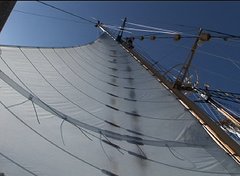 |
I grab a pair of binoculars from the wall of the lab and head out to the quarterdeck with a sometimes reluctant, sometimes excited fellow classmate. For ten minutes we scan the horizon on either side of the boat looking for any possible flap of a wing, every possible soaring bird, any sign of life over the big blue ocean. My classmate Annie and I are interested in where we see birds during our trip because we are working on a project on seabird distribution, and are interested in why we sea birds where we see them. Is it related to how far they are from land? Does it say something about how much food is in the water they soar above? Being some of the only visible organisms in this watery world, birds have the potential to answer many scientific questions about productivity and ecology in the open ocean. Being an ecologist, my interest in seabirds was purely in this ecological frame of mind until, after a chance encounter on a walk through the streets of London, Kiritimati Island, I found out that other people have considered birds important for reasons other than being ecological indicators.
A hand-painted sign along the pot-holed main thoroughfare of London, Kiritimati Island, advertised the "Wildlife Protection and Management" office. I stepped into a room devoid of decoration, save for the posters of the biology and identification of the 25 different bird species that nest and live on the atoll. I immediately wished I had brought a pen to write down all the Gilbertese words for all the birds I've been scanning the horizon for since we left Honolulu. The woman behind the counter came up and asked us if we had any questions, and we began to talk. She knew about the SSV Robert C. Seamans from previous trips SEA has taken to Kiritimati, and she knows that students onboard are often studying birds on SEA trips.
"We are interested in birds, too, because historically, Polynesian navigators used them for navigation," she tells me. " The greater frigatebird, for example, is always found near land. This is because they are lazy, and like to wait around for other birds to come home, and then they steal food from the birds that are returning. Polynesian navigators who saw frigatebirds in the sky would follow them because they would always lead their boats to land."
On the journey home over the next ten days, I'll be madly trying to input and analyze data to see if any of the trends in bird distribution Annie and I hoped to see are real. But while I'm doing that, I won't forget to scan the horizon from time to time, looking for those frigatebirds that are going to be leading the Seamans back to Hawaii.
-Ana Miller-ter Kuile


3 comments:
So cool! This sounds like a really great project, I can't wait to see the results!
Btw, I love the picture of the seabirds silhouetted against the clouds. :)
Banuni, may those lazy greater frigate birds show you the way home safely and soon! We are too far inland to "sea" them, but we have others birds to see and to enjoy. Can't wait to hear about your project and your adventures.
Post a Comment